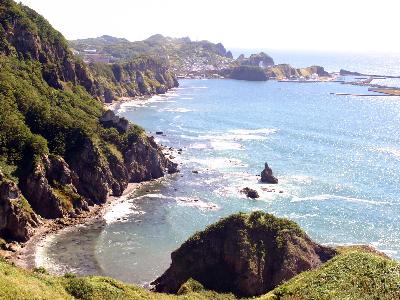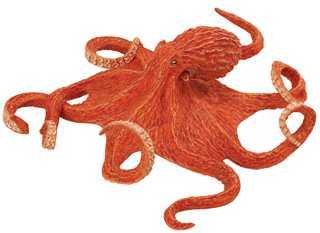
November 17, 2012
The indigenous Ainu people of Japan have long told of an enormous marine animal known as the Akkorokamui. The creature is said to lurk in Funka Bay, also known as Uchiura Bay or Volcano Bay, which is located in the Southwestern portion of the Northern Japanese island of Hokkaido.


Location of Funka Bay
The bay is ringed on three sides by Oshima peninsula and is surrounded by the volcanoes Mt. Usu and Mt. Komagatake.

Funka Bay
The Akkorokamui is said to be a gigantic octopus-like or squid-like creature, reaching sizes of up to 110 meters in length. The coloration of the Akkorokamui is said to be a striking red, often described as almost incandescent and sometimes likened to the color of the reflection of the setting sun upon the water.
Due to this coloration and the creature’s immense size, it is believed that the Akkorokamui is visible from a great distance away. The Ainu people have always feared the Akkorokamui, believing it to be an aggressive beast with a tendency to attack and swamp boats. Fishermen were often known to carry large sickles aboard their boats in order to protect themselves from the creature.
In addition to the long history of folklore and alleged sightings of the Akkorokamui made by Ainu, there are accounts written of by non Ainu as well. The 19th century Englishman and missionary John Batchelor, who lived among the Ainu and is known for his extensive writings on Ainu life, wrote firsthand a journal entry of an alleged actual incident concerning an apparent Akkorokamui in his book The Ainu and their Folklore.
In the morning, we found the whole village under a cloud. Three men, it was said, were out trying to catch swordfish, when all at once a great sea monster, with large staring eyes, appeared in front of them and proceeded to attack the boat. A desperate fight ensued. The monster was round in shape, and emitted a dark fluid and noxious odor. The three men fled in dismay, not so much indeed for fear, they say, but on account of the dreadful smell. However that may have been, they were so scared that the next morning all three refused to get up and eat; they were lying in their beds pale and trembling.
Another old 19th century account was made by a Japanese fisherman which I have translated from the original Japanese.
And I saw ahead something huge and red undulating under the waves. I at first thought my eyes deceived me and that I was merely seeing the reflection of sun upon the water, but as I approached, I could see that in fact it was an enormous monster, 80 meters in length at least, with large, thick tentacles as big around as a man’s torso. The thing fixed me with a huge, staring eye before sinking out of sight into the depths.
Other eyewitness reports of the creature have surfaced over the years as well, including into modern days. These sorts of reports are all very similar to old sea serpent sightings in the West, which leads me to wonder if there is perhaps some unknown animal lying at the heart of some of these stories. For example, based on descriptions and accounts, it has been speculated that there is perhaps a type of undiscovered, giant octopus in the bay or even a super sized known species of octopus.
Indeed, what is often considered to be the largest species of octopus is known to inhabit Japanese waters. The giant pacific octopus (Enteroctopus dofleini) is a very large species of octopus found throughout the coastal north Pacific, including Japan. These creatures have arm spans of up to 3 to 5 m (9.75 to 16 ft) and can weigh as much as 10 to 50 kg (22 to 110 lbs), with unconfirmed reports of even larger specimens.
Size comparison of a giant Pacific octopus with a 6 foot tall man
Giant Pacific octopuses also are known to display a red coloration similar to what is reported with the Akkorokamui, although they are able to change their pigmentation in order to blend in to their environment.
Giant Pacific octopus
It would not be that unusual to find a giant Pacific octopus in Funka Bay. However, there are several factors that make this explanation problematic. One is that this species is usually found at depths of over 200 feet. They can be found in shallower water as well, but it seems that this is not a species that spends a lot of time at the surface where it would readily be witnessed.
Also, the sizes reported for the Akkorokamui are much larger than any giant Pacific octopus would likely ever get. Traditional stories of creatures 110 meters long (about 361 feet) boggle the mind. That would be much bigger than any living sea creature we know of. Even if we are to disregard these quite improbable extreme sizes reported in Akkorokamui lore, it stretches credibility to think of any giant octopus getting even close to that measurement, or indeed even close enough to be mistaken for something so big.
Of course one cannot look at these possibilities without considering giant squid as well, although again these would be found in deep water, with perhaps only injured or dying individuals making their way to the surface.
Giant squid
Again, we are faced with size issues, yet surely there is the possibility of specimens of giant octopus or giant squid out there even larger than those we have managed to measure thus far. It is not known exactly how big these creatures are capable of getting and the new discoveries of humongous squids such as the colossal squid (Mesonychoteuthis hamiltoni) lead me to think that there are still large octopuses and squid out there that surpass current known maximum sizes.
Another possible explanation for the Akkorokamui could also perhaps be found in the granrojo (big red) jellyfish (Tiburonia granrojo). This species represents a whole new subfamily of jellyfish, and was only discovered in 2003. These little understood jellyfish are known from only 23 individuals and get their name from their red coloration and large size, reaching over 1 meter (about 3 feet) in diameter.
The granrojo jellyfish
These jellyfish have been found in Japanese waters, so it is perhaps possible that one, or something like it, could have made it into Funka Bay. However, again we are faced with size issues, as the granrojo is even smaller than the giant Pacific octopus, with the larger ones measuring around 1 meter in diameter. In addition, the granrojo is thought to typically dwell in very deep water at cold, dark depths of around 645 meters (2,100 feet). This makes it unlikely they would be observed at the surface and is indeed one reason why they remained discovered until 2003.
It is obvious that we are still finding new creatures in the deep and that some of these organisms get get quite large. It is not completely far-fetched that some unknown large species such as these could be possibly behind stories of the Akkorokamui. Although the Akkorokamui is most often thought of as merely part of Ainu folklore, is there a chance that it could be more than that? Could stories of this creature be based in some way on a real, living animal?

The ocean depths are still a source of new surprises and zoological mysteries, and likely will be for some time. As we delve deeper into the seas, we will undoubtedly come across startling discoveries. With cryptids such as the Akkorokamui, I wonder if there is a point where folklore, real animals, and the true unknown collide.
About mystery_man
Filed under Cryptotourism, Cryptozoology, Eyewitness Accounts, Folklore, Mystery Man's Menagerie, Sea Monsters